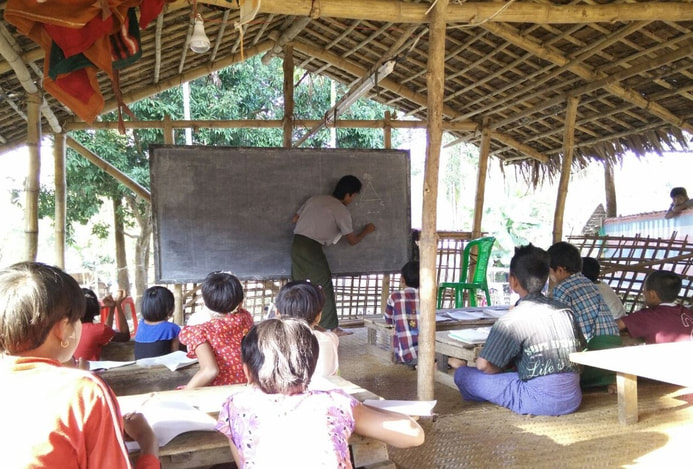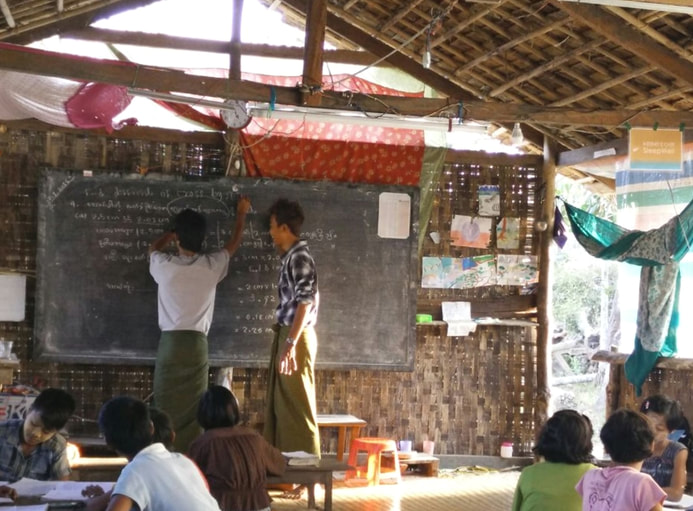|
One of the students learning English showed great potential as a teacher during the Yangon teaching training, and I was keen to watch him in his natural environment. In Yangon, his English had been very low in the beginning, but he made impressive gains over the month, and clearly listened to what I said and paid close attention to what I did during class. In fact I noticed that he has a very good eye for detail when I returned to the village this time; I used to have a bright yellow phone cover, but during my holiday exchanged it for a more sombre clear one. His first question after greeting me was ‘do you have a new phone?’ as he immediately noticed the different color. The other student admitted that he had no idea what color my phone was; only that I had one! The English vocabulary of this student is pretty wide, but he suffers from a shyness when speaking and a very thorough deliberateness with his word choice which makes conversation slower than I would expect for an intermediate level student. I wanted to see if this careful, shy personality was just how he comes, or if it was the use of English that brought out those qualities. I suspected it was a natural part of him which was exacerbated when he spoke in a third language. (The first being Arakanese, the second is Burmese or Myanmar; the language of the ruling government who are of Bamar ethnicity.) I was taken to two classrooms to greet the grade 8 and 9 students; some of whom I met last time I visited. I’m sure that I must have seen all of them, but as only some of them introduced themselves, those are the ones I most remember. The grade 8 girls giggled as they reminisced about playing in the river with me a little over a month ago. Once again, my student teacher was great at translating and encouraging the students to speak with me. When we arrived in the grade 7 classroom, we were met with 20 children. I sat at the front to be introduced and then headed to a comfortable and unobtrusive position at the back of the classroom. However, unobtrusive is not an accurate word to describe my presence in the village and the children kept stealing glances at me over the course of their maths instruction on the angles of a triangle. The tired blackboard wobbles on the bamboo stick that it is strapped to and the thin bamboo walls ripple in the evening breeze. The bright sunshine is setting over the empty paddy fields illuminating the class when the children chant in unison as the volunteer teacher neatly chalks up the solutions to the questions set in the government textbook. Although there is no active learning as I would like to see it, the children are, to my surprise, all engaged and all of the 20 students happily shout out the answers to the questions. Apart from stolen glances at me, the children fully concentrate on their book and their teacher. They recite the answers as the teacher writes it up on the board, and only after an explanation from the teacher do the pupils copy down the text from the blackboard into their books. I see that the volunteer teacher is more confident instructing pupils in his native tongue, but a lot of his gestures carry over and his penchant for saying sorry is still evident. I am a little sad to see that the promise that he showed in Yangon and again in encouraging the children to converse with me did not seem to translate into the math class. I wonder if he has compartmentalized English instruction with active group learning while other subjects are still in the rigid traditional style. He left his class to do problems while he took me to visit the grade 8 maths class run by one of the 20 volunteer teachers I had observed. This is obviously not part of a normal lesson. It does slightly frustrate me that things become special when I arrive, but I must appreciate that my being in the village is a most unusual state of affairs and that they only want to make me happy and show me the best side of their teaching and learning. We return to the grade 7 students who are having some discussion over some questions in their textbook. The volunteer teacher then holds up the textbook to the correct page and spiels off the answers to the children. There seems to be some slight disagreement over the answers from a few of the children, and I am heartened to see that there is some engagement with debate and criticism of the given answers even if it is minimal. I do not like the robotic uni-voice that erupts from the tables, nor do I like the very teacher-centric way of instructing these students. However, change is always slow and I very much hope that the change started in October in Yangon and will slowly seep into the classes I witnessed today. My main objective was to assess the teaching character of my student, and I feel that goal was accomplished. He is entrenched in a hierarchy of bad teaching, but I think that he has the inherent personal qualities required to break free from that moulding to create a vibrant classroom environment.
Chloe Smith NEH Coordinator and Teacher Trainer Related Posts: Observing Teacher Training Observing Students in Class Observing Grade 8 English Observing Grade 7 English Observing the Monk's Class Observing a Student-Run Lesson Observing Teachers
Comments
|
This section will not be visible in live published website. Below are your current settings: Current Number Of Columns are = 3 Expand Posts Area = 1 Gap/Space Between Posts = 20px Blog Post Style = card Use of custom card colors instead of default colors = Blog Post Card Background Color = current color Blog Post Card Shadow Color = current color Blog Post Card Border Color = current color Publish the website and visit your blog page to see the results |
|
© New Education Highway 2024
Except where otherwise noted, content on this site is licensed under a Creative Commons Attribution 4.0 International License. |




